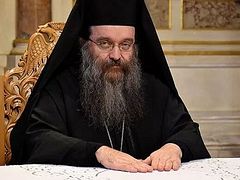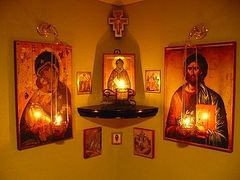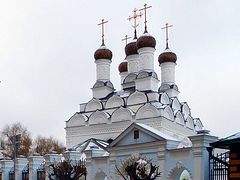Wayne, West Virgina, March 18, 2020
 Photo: Facebook As Orthodox parishes continue to severely reduce their liturgical schedules or close altogether, a number of monasteries and parishes have begun offering livestreams of their services for the faithful to join them in prayer from home.
Photo: Facebook As Orthodox parishes continue to severely reduce their liturgical schedules or close altogether, a number of monasteries and parishes have begun offering livestreams of their services for the faithful to join them in prayer from home.
Among them is Holy Cross Monastery in Wayne, West Virginia of the Russian Orthodox Church Outside of Russia, which will be livestreaming all of its services throughout the period of the epidemic.
In order to console and nourish the faithful who are quarantined, Archimandrite Seraphim has blessed for the monastery church services to be livestreamed for the duration of this crisis. While viewing the services over the internet is certainly less than ideal, nevertheless it is the only way that many of the faithful now have to participate in divine worship. We wish to make our life of prayer for the world, which will continue unabated, available to those confined to their homes or who are otherwise unable to worship in their parish temple during this trying time.
Their services can be streamed on both Facebook and YouTube.
In addition to the regularly scheduled services, the brotherhood will also gather at 12:00pm Eastern today to pray a Moleben in Time of Devastating Epidemic to the holy Great-Martyr and Healer Panteleimon and to St. Nikephoros the Leper, which will also be livestreamed.
St. Nikephoros, a 20th-century saint who suffered from leprosy for many decades, has emerged as a major saint to turn to during this time of crisis after word spread that he had appeared to an old man in Greece earlier this month, telling him not to fear the virus, because he would protect and heal all those who have faith and turn to him in prayer.
Fr. Ananias Koustenis speaks about this appearance in a recently-published video.
St. Nicholas Greek Orthodox Church in San Jose announced on March 10 that it will also be serving the Paraklesis service to St. Nikephoros for the next several Saturdays.
Holy Trinity Greek Orthodox Cathedral in Phoenix has also published a reflection on the life of St. Nikephoros with a Paraklesis to him.
According to His Eminence Archbishop Kyrill of the Western American Diocese of ROCOR, the holy Archangel Michael has also appeared to many people suffering from the virus, promising them his powerful help.
***
The Life of St. Nikephoros the Leper from the site of the Orthodox Church in America:
Father Nikephoros (Nicholas Tzanakakis in the world) was born in 1890 in a mountainous village in Khania, in Sikari, Kastanohori to the west of the prefecture with a healthy climate, with beautiful forests, rich waters, gorges and caves. This village has a peculiarity that we do not often encounter: it is divided into eleven neighborhoods, which have also been named after the families who first settled there. So Saint Nikephoros was born in the neighborhood of Kostoyianides.
His parents were simple and pious villagers, who died when he was still a young child, leaving him as an orphan. So, at the age of thirteen, he left his home. His grandfather, who had undertaken to raise him, went to Khania to work there in a barber shop in order to learn the job. Then he showed the first signs of Hansen’s disease, i.e. leprosy. The lepers were isolated on the island of Spinalonga because leprosy was a contagious disease and it was treated with fear and dismay.
Nicholas was sixteen years old when signs of the disease began to become more conspicuous, so he left on a boat to Egypt in order to avoid being confined to Spinalonga. He remained in Alexandria, working in a barber shop again, but the signs of the disease became more and more apparent, especially on his hands and face. That is why, through the intervention of a cleric, he went to Chios, where there was a church for lepers at that time, and the priest was Father Anthimos Vagianos, later Saint Anthimos (February 15).
Nicholas arrived in Chios in 1914 at the age of twenty-four. In the leper hospital of Chios, which was a complex with many homesteads, there was a chapel of Saint Lazarus, where the wonderworking icon of Panagia Ypakoe (Feb. 2) was kept. In this space, the course of virtues was opened for Nicholas. Within two years Saint Anthimos considered him ready for the angelic Schema and tonsured him with the name Nikephoros. The disease progressed and evolved in the absence of suitable drugs, causing many large lesions (a drug was found in 1947).
Father Nikephoros lived with unquestioning, genuine obedience to his Spiritual Father, and with austere fasting, working in the gardens. He also recorded the miracles of Saint Anthimos, which he had witnessed with his own eyes (many of these were related to the deliverance of those possessed by demons).
There was a special spiritual relationship between Saint Anthimos and the monk Nikephoros, who always remained close to him, as Father Theoklitos Dionysiatis writes in his book Saint Anthimos of Chios. Father Nikephoros prayed at night for hours on end making countless metanias, he did not quarrel with anyone, nor injure anyone's heart, and he was the master chanter of the temple. Because of his illness, however, he slowly lost his sight, and so he chanted the troparia and the Epistles from memory.
The Chios leprosarium was closed in 1957 and the remaining patients, together with Father Nikephoros, were sent to Saint Barbara’s home for lepers in Athens, in Aigaleo. At that time, Father Nikephoros was about 67 years old. His members and his eyes were completely altered and distorted by the disease.
There, Father Eumenios also lived there at the home for lepers. He also suffered from Hansen’s disease, but with the medication he received, he was completely cured. However, he decided to remain in the home for lepers for the rest of his life near his fellow sufferers, caring for them with much love. Thus he submitted to Father Nikephoros, to whom the Lord had given many gifts as a reward for his patience. A crowd of people gathered in the humble cell of the leper Nikephoros, in Saint Barbara in Aigaleo to obtain his prayers. Here are some testimonies of those who met him:
“While he was prostrate with wounds and pains, he did not complain, but he showed great patience.”
“He had the charisma of consoling those who were sad. His eyes were permanently irritated, and he had limited sight. He also had stiffness in his hands and paralysis in his lower limbs. Nonetheless, he endured all of this in the sweetest, meek, smiling, delightful way, and he was also pleasant and lovable.”
“His face, which was eaten away by the marks of his illness, and his wounds, shone. It was a joy for those who saw this destitute and seemingly feeble man saying, May His holy name be glorified.”
Father Nikephoros reposed on January 4, 1964 at the age of 74. After three years, his holy relics were exhumed and found to be fragrant. Father Eumenios and other believers reported many cases where miracles occurred by calling on Saint Nikephoros to intercede with God.
The life of Saint Nikephoros was a brilliant example and model for everyone. He was pleasing to God because he had endured so much. For this reason, we have many testimonies that our saint received from the Holy Spirit the gift of discernment as and a host of other charisms. We should note that most of the miracles are recorded, and today the saint gives generous help to anyone in need. Surely there will be many more miracles which not have not yet been made manifest.




